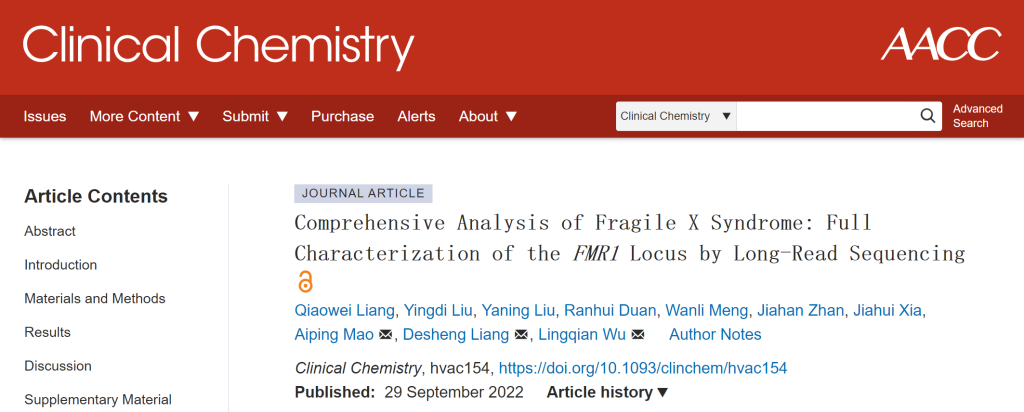Recently, the original clinical technology research resultComprehensive Analysis of Fragile X Syndrome: Full Characterization of the FMR1 Locus by Long-Read Sequencingby Prof. Wu Lingqian and Prof. Liang Desheng’ team of the Center for Medical Genetics, School of Life Sciences, Central South University, has been online published in the top international academic journalClinical Chemistry. This is another major breakthrough for the team to explore new technologies for diagnosing diseases with complex genetic variants based on the third-generation/single-molecule long-read sequencing platform. Liu Yingdi, a PhD student at CSU, is the co-first author of the paper, and Wu Lingqian and Liang Desheng are co-corresponding authors, in collaboration with Hunan Jiahui Genetic Specialist Hospital and Berry Genomics.

Fragile X syndrome (FXS) is the most common monogenic disorder in intellectual disability and autism spectrum disorders, with an incidence of 1/4000 in men and 1/6000-1/8000 in women. 95% of FXS patients are caused by amplification of the (CGG)n trinucleotide repeat sequence in the 5'-untranslated region of the FMR1 gene. The CGG region of female premutation (55-200 CGG repeats) carriers is unstable, and has a high chance (about 80%, the higher the number of CGG repeats, the higher the chance) to expand to a full mutation (>200 CGG repeats) during transmission to offspring, resulting in the birth of FXS patients. Since the carrier rate of premutation in women is as high as 1/200-1/600, carrier screening for women of childbearing age or early pregnancy is the best means of prevention and control. Moreover, premutation carriers are at increased risk of developing fragile X-related disorders: tremor/ataxia syndrome in men and primary ovarian insufficiency and neuropsychiatric disorders in women. Therefore, accurate genetic screening and diagnosis are crucial for the prevention and control of FXS.
The genetic variants of FXS are complex and diverse, and there is a lack of comprehensive, accurate, and efficient genetic testing method to date. Due to the influence of the ultra-high GC content of (CGG)n, both first- and second-generation sequencing cannot effectively detect it. Currently, triple repeat-primed PCR (TP-PCR) and DNA southern blot (SB) are routinely used in clinical practice, but the length of the (CGG)n detected is limited, and the location and number of AGG interruptions cannot be determined, and AGG interruptions are very important for patient prognosis determination and offspring risk prediction. Moreover, studies have shown that 12%-41% of FXS patients are mosaicism, and detection of low-proportion premutation and full mutation mosaicism is particularly important for FXS carrier screening and patient diagnosis, while conventional methods are difficult to achieve accurate detection of low proportion mosaicism. In addition, single nucleotide variants (SNVs), short insertions or deletions (Indels) and large deletions within the FMR1 gene account for about 5% of FXS etiology, which require a combination of different technical approaches to detect and are expensive. The research team has developed a new method for comprehensive analysis of FXS (CAFXS) combining long fragment PCR (LR-PCR) and third-generation sequencing, which can detect all variant types such as (CGG)n amplification, AGG interruption, intragenic SNVs, Indels, microdeletions and large fragment deletions at one time, and can also detect premutation and full mutation low proportion mosaicism (as low as 0.5%), truly realizing comprehensive, accurate and efficient genetic screening and diagnosis of FXS. The detection cost of this method is close to that of conventional methods, and the sensitivity and specificity reached 99.9% in retrospective clinical trials, so it has broad clinical application prospects.
Professor Wu Lingqian and Liang Desheng's team has been at the forefront of international research in clinical application of new technologies for genetic diagnosis and prenatal diagnosis of genetic diseases. Following the publication of the research results of third-generation sequencing in the detection of congenital adrenocortical hyperplasia (CAH) in June this year, the CAFXS research results are again published in top international journals. At present, third-generation thalassemia and CAH detection technologies have been applied in large-scale clinical applications in China, and a new technology system for the precise prevention and control of birth defects by third-generation sequencing has been gradually established in China.
Source: School of Life Sciences
Authors: Liu Yingdi, Hu Yiqiao